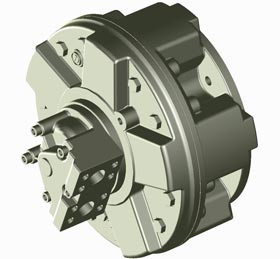
GS - Crankshaft design radial piston hydraulic motors
Crankshaft design radial piston motors
The main characteristics of this type of design are high mechanical efficiency,
especially at start up, and high volumetric efficiency.
A number of features distinguish SAI motors from other radial piston designs:
- Swivelling cylinder: the cylinder (1) remaining aligned with the eccentric of the crank (3), eliminates side loading between the cylinder and piston (2). The articulation of the cylinder-piston assembly is achieved with large diameter trunnions (4) ensuring low specific loads.
- Double piston support bearing: the pistons transmit their load to the shaft via a hydrostatic bearing (5) and a central roller bearing (6). The roller bearing minimises the sliding velocity between the piston foot and the spherical piston support ring, reducing heat, friction, wearing and improving starting torque, low speed operation (reduced stick slip) and high speed operation. The hydrostatic bearing reduces metal-metal contact ensuring optimal lubrication and low friction.
- Piston retaining rings(7) ensure the piston remains in contact with the shaft in all operating conditions, even during cavitation.
- Rotary axial distributor(8) ensures optimal distribution with short, large section ducts for reduced power-loss with high flows, and very high volumetric efficiency; extensive clearance recovery capability of the seals ensures optimal functionality throughout the motor lifetime and in conditions of thermal shock.
The S-series high speed motors have max speeds which are 2-3 times higher than those normally expected in LSHT motors.
Low speed
The radial piston design ensures excellent low speed characteristics.
High specific speed range
The ratio (max.speed): (min.speed) is higher than any other type of equivalent hydraulic motor, giving greater flexibility of application.
High power ratings
The rugged design of the motors and their high operating efficiency enable high continuous powers to be transmitted.
Disc Cage
Hydraulic motor makes the most of speed with disc cage on crankshaft central roller bearing. This particular kind of cage offers two ematkable advantages, compared to most of the cages available on the market:
-minimize heat generation, due to the reduced friction area;
-maximize heat dissipation, as surfaces of the rolling parts are easier to flux.
The high speed capability, with equivalent high power ratings, is possible due to the following factors:
Forced lubrication of all load-bearing surfaces -
hydraulic balancing of piston foot, cylinder trunnion and distributor rotor;
Low sliding speeds of load bearing surfaces -
compact distributor rotor, central piston support bearing, cylinder trunnions.
High dynamic stability of the pistons-
the sleeves of the oscillating cylinder have been extended so giving the piston added directional guidance.
Also, the lightweight, single-component design of the piston minimises the effects of inertial forces at high speeds. The stability of the piston is further helped by the spherical surface of the piston-support ring which favours self-centring of the piston at high speed and eliminates stick-slip phenomena at low speeds.
Mechanical, non-elastic piston guidance design-
the pistons follow the shaft eccentric without separation and hammering under all normal and anomalous hydraulic or mechanical operating conditions (cavitation, high case pressure, vibration, centrifugal forces, etc.).
Surface finishing
of the pistons and cylinders to prevent seizure.
Increased cylinder-wall thicknesses
and stronger cylinder trunnions for stiffer, higher strength cylinders.
|
general characteristics and features |
||||
| article | click to enlarge the photo |
displacement (cm³/rev) |
specific torque (Nm/bar) |
technical data pdf |
| GS05 | 39 - 111 |
0.61 - 1.73 |
||
| GS1 | 99 - 243 |
1.54 - 3.80 |
||
| GS2 | 192 - 493 |
3.00 - 7.69 |
||
| GS3 | 352 - 792 |
5.49 - 12.4 |
||
| GS4 | 402 - 1116 |
6.27 - 17.4 |
||
| GS5A | 526 - 1816 |
8.22 - 28.3 |
||
| GS6 | 1690 - 2513 |
26.4 - 39.2 |
||